Two long and low quality videos from GDC are now up with Vulkan as the subject, all very interesting with Oxide Games and Valve speaking.
I've done some highlights for you. The audio is pretty terrible at times, as I've had to sit here with my volume slider going up and down to hear parts.
Developer focused video

More background info from Khronos
They started the originally discussion to re-do OpenGL back in October 2012, earlier than they had mentioned at all previously. It wasn't a top priority, and it dragged on.
In June/July 2014 it became GL Next and became a top priority. Mantle, DirectX 12 and Metal came along and they realised OpenGL would be left behind. AMD donates Mantle.
Renamed and disclosed to the world at GDC 2015.
Public launch of Vulkan February 16th, 2016.
More info about Vulkan
He says they wanted a clean slate, but clean doesn't mean simple. He says not to think of Vulkan as a graphics API, but to think of it as an API for controlling graphics and compute hardware.
They aimed for increased reliability due to developers comments about OpenGL bugs and different implementations.
They have a conformance test, but right now it's very immature.
About Open Source
They had to do some things in secret due to lawyers and patents. They are still working on their CLA with lawyers to allow others pull requests. They should be able to take pull requests against the specification and code by next week.
The move to open source has been really good for them, with people helping to find typos, header file improvements, specification errors and so on. (Editor note: Who would have thought making it open source would bring in people to help eh? ;))
There's a lot more companies involved in Vulkan than I thought including Lucasfilm, Sony, Google, PIXAR, Nintendo, and so on.
Nvidia talking about Vulkan
They have to do less driver magic, less guessing and this gives them simpler drivers. All the expensive stuff is under each applications control.
They say it's not a true low-level API, they maintain higher level abstractions. They say a true low-level API would mean applications would have to code in IHV specific code paths.
There are differences between Nvidia, AMD and Tilers (mobile):
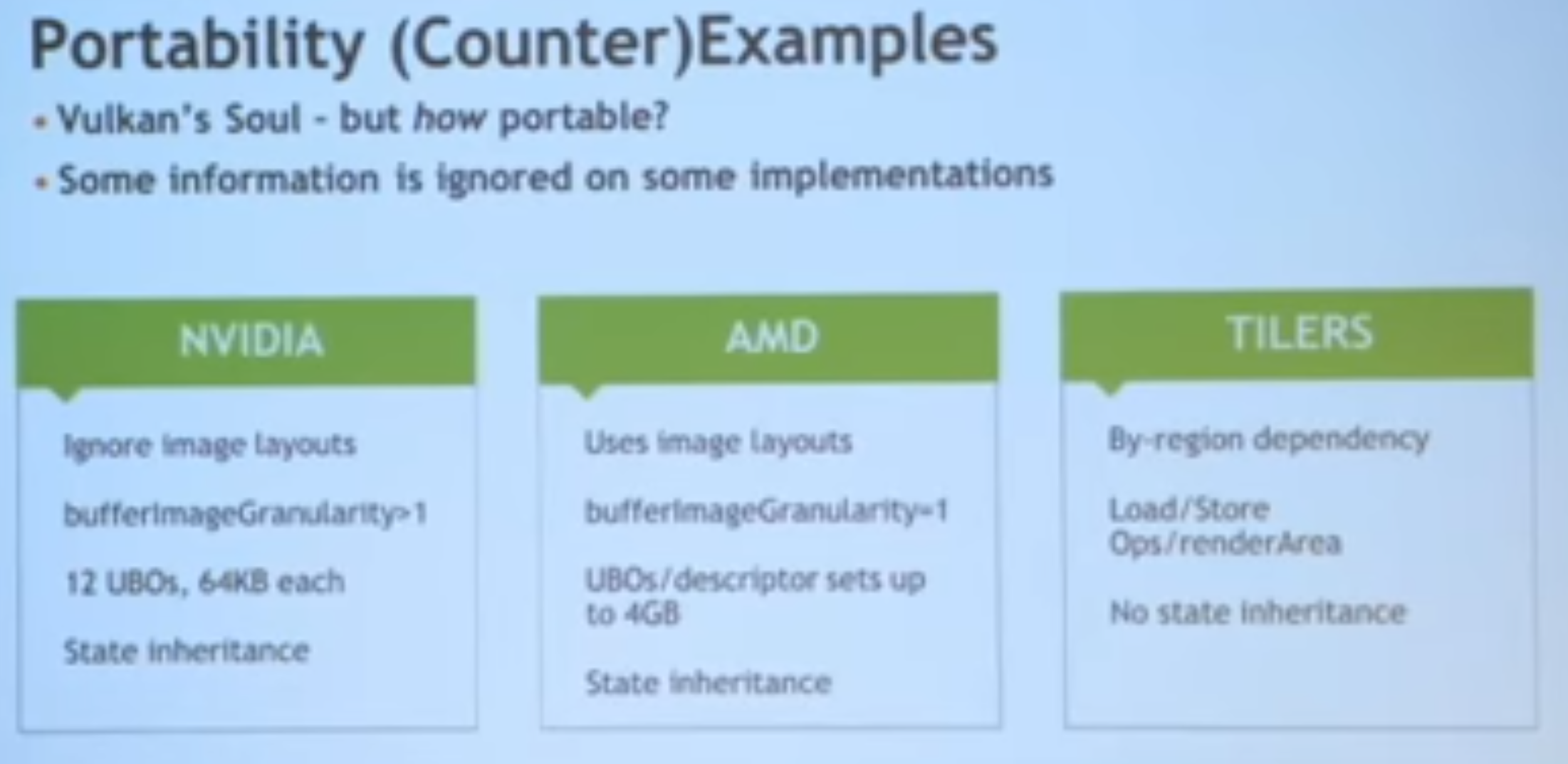
More developer stuff, Oxide Games and Valve
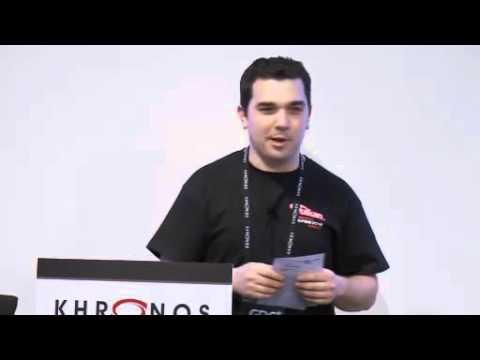
Oxide games (Ashes of the Singularity) about Nitrous engine
Old API's were holding them back.
Mentions again how similar DirectX 12 and Vulkan are, and if you do one you should do the other.
Valve about Dota 2, About 1:26:54
Valve state the Source 2 powered Dota 2 Reborn has a completed Vulkan rendering system now, and they have shipped it to "IHVs" (independent hardware vendors). They have it running on AMD, Nvidia and Intel on both Windows and Linux.
Scaleform are working on a Vulkan back-end that Valve need for some of their UI, so they are waiting on them.
Valve state that Dota 2 isn't the best performance mark for Vulkan as it's not doing a lot, and they aren't using certain Vulkan features yet they will do in future, and they think they will improve performance on it.
The latency is a lot lower (better) in Vulkan than DirectX 9 in Dota 2.
In the first Nvidia test (a portion of a normal match):
In FPS terms Vulkan beats OpenGL. DirectX 9 beats them both and all of them beat DirectX 11.
In the second Nvidia test (a big battle, lots going on):
In FPS terms Vulkan beats all. OpenGL and DirectX 9 evenly matched and again they all beat DirectX 11.
He sums it up as this:
- Significant latency reduction
- Improved framerate in heavy scenes
- Only going to get better
He then comments that all IHVs (AMD, Nvidia, Intel) drivers with Vulkan are already very efficient (which is pleasing to hear!).
Then he goes into lessons they learned hoping it helps others. Finally there's a Q&A section.
There are more talks going on today too, so hopefully I can write them up as well.
I've done some highlights for you. The audio is pretty terrible at times, as I've had to sit here with my volume slider going up and down to hear parts.
Developer focused video

YouTube videos require cookies, you must accept their cookies to view. View cookie preferences.
Direct Link
Direct Link
More background info from Khronos
They started the originally discussion to re-do OpenGL back in October 2012, earlier than they had mentioned at all previously. It wasn't a top priority, and it dragged on.
In June/July 2014 it became GL Next and became a top priority. Mantle, DirectX 12 and Metal came along and they realised OpenGL would be left behind. AMD donates Mantle.
Renamed and disclosed to the world at GDC 2015.
Public launch of Vulkan February 16th, 2016.
More info about Vulkan
He says they wanted a clean slate, but clean doesn't mean simple. He says not to think of Vulkan as a graphics API, but to think of it as an API for controlling graphics and compute hardware.
They aimed for increased reliability due to developers comments about OpenGL bugs and different implementations.
They have a conformance test, but right now it's very immature.
About Open Source
They had to do some things in secret due to lawyers and patents. They are still working on their CLA with lawyers to allow others pull requests. They should be able to take pull requests against the specification and code by next week.
The move to open source has been really good for them, with people helping to find typos, header file improvements, specification errors and so on. (Editor note: Who would have thought making it open source would bring in people to help eh? ;))
There's a lot more companies involved in Vulkan than I thought including Lucasfilm, Sony, Google, PIXAR, Nintendo, and so on.
Nvidia talking about Vulkan
They have to do less driver magic, less guessing and this gives them simpler drivers. All the expensive stuff is under each applications control.
They say it's not a true low-level API, they maintain higher level abstractions. They say a true low-level API would mean applications would have to code in IHV specific code paths.
There are differences between Nvidia, AMD and Tilers (mobile):

More developer stuff, Oxide Games and Valve

YouTube videos require cookies, you must accept their cookies to view. View cookie preferences.
Direct Link
Direct Link
Oxide games (Ashes of the Singularity) about Nitrous engine
Old API's were holding them back.
Mentions again how similar DirectX 12 and Vulkan are, and if you do one you should do the other.
Valve about Dota 2, About 1:26:54
Valve state the Source 2 powered Dota 2 Reborn has a completed Vulkan rendering system now, and they have shipped it to "IHVs" (independent hardware vendors). They have it running on AMD, Nvidia and Intel on both Windows and Linux.
Scaleform are working on a Vulkan back-end that Valve need for some of their UI, so they are waiting on them.
Valve state that Dota 2 isn't the best performance mark for Vulkan as it's not doing a lot, and they aren't using certain Vulkan features yet they will do in future, and they think they will improve performance on it.
The latency is a lot lower (better) in Vulkan than DirectX 9 in Dota 2.
In the first Nvidia test (a portion of a normal match):
In FPS terms Vulkan beats OpenGL. DirectX 9 beats them both and all of them beat DirectX 11.
In the second Nvidia test (a big battle, lots going on):
In FPS terms Vulkan beats all. OpenGL and DirectX 9 evenly matched and again they all beat DirectX 11.
He sums it up as this:
- Significant latency reduction
- Improved framerate in heavy scenes
- Only going to get better
He then comments that all IHVs (AMD, Nvidia, Intel) drivers with Vulkan are already very efficient (which is pleasing to hear!).
Then he goes into lessons they learned hoping it helps others. Finally there's a Q&A section.
There are more talks going on today too, so hopefully I can write them up as well.
Some you may have missed, popular articles from the last month:
All posts need to follow our rules. For users logged in: please hit the Report Flag icon on any post that breaks the rules or contains illegal / harmful content. Guest readers can email us for any issues.
From technical presentations:
* AMD Windows Vulkan driver compilant now;
* Validation tool in future having profiles of devices so you get indication how good/bad your code will run on all supported devices;
* Quite a freedom to screw around, Vulkan won't do validation during runtime;
Overall very impressed how united industry is behind Vulkan. It will enable Linux for gaming, guaranteed.
* AMD Windows Vulkan driver compilant now;
* Validation tool in future having profiles of devices so you get indication how good/bad your code will run on all supported devices;
* Quite a freedom to screw around, Vulkan won't do validation during runtime;
Overall very impressed how united industry is behind Vulkan. It will enable Linux for gaming, guaranteed.
4 Likes, Who?
Anybody has the slides? It's hardly visible on the video...
1 Likes, Who?
Updated with more info from the first video.
2 Likes, Who?
I hope Sony involvment means they look for possibility to add Vulkan API to PS4. Considering Vulkan driver is so much easier to support and it is much closer to what they have now, it would be a killer move.
2 Likes, Who?
'Who would have thought making it open source would bring in people to help eh?'
Yeah, who ... :D
Sad they do not release it with copyleft. If vulkan get to replace DX, their licence would allow brand like nvidia to make some closed source add-on that would work only on their hardware or just better on it, just to screw up competition as they do now.
Yeah, who ... :D
Sad they do not release it with copyleft. If vulkan get to replace DX, their licence would allow brand like nvidia to make some closed source add-on that would work only on their hardware or just better on it, just to screw up competition as they do now.
1 Likes, Who?
I hope Sony involvment means they look for possibility to add Vulkan API to PS4. Considering Vulkan driver is so much easier to support and it is much closer to what they have now, it would be a killer move.
?????
Easier to support than what?
Both XBone and PS4 dont need Vulkan or DX12. Games are developed
particularly for their hardware.
0 Likes
I hope Sony involvment means they look for possibility to add Vulkan API to PS4. Considering Vulkan driver is so much easier to support and it is much closer to what they have now, it would be a killer move.
?????
Easier to support than what?
Both XBone and PS4 dont need Vulkan or DX12. Games are developed
particularly for their hardware.
Yes, but if PS4 (or 5) supported Vulkan, a game built for Vulkan would be able to run on Linux, Mac, Windows 7-10, SteamOS, PS4 and Android; that's pretty much every platform out there apart from XBox and Wii U (but Nintendo's in the group as well... we'll see). On the other hand, a game built for DX12 is able to run on XBox and only the latest version of Windows, that's it.
Of course, games still need to be tweaked to run on each platform, but with Vulkan, it's just optimisation and code path changes, not an entirely new port.
Last edited by Cybolic on 17 Mar 2016 at 12:40 pm UTC
1 Likes, Who?
'Who would have thought making it open source would bring in people to help eh?'
Yeah, who ... :D
Sad they do not release it with copyleft. If vulkan get to replace DX, their licence would allow brand like nvidia to make some closed source add-on that would work only on their hardware or just better on it, just to screw up competition as they do now.
It is developer choice to choose such vendor extensions and not to add AMD alternatives when needed. Partially because AMD haven't offered ones, nor their performance has been great for devs to actually care.
0 Likes
I hope Sony involvment means they look for possibility to add Vulkan API to PS4. Considering Vulkan driver is so much easier to support and it is much closer to what they have now, it would be a killer move.
?????
Easier to support than what?
Both XBone and PS4 dont need Vulkan or DX12. Games are developed
particularly for their hardware.
XBone uses DirectX 11.3 special edition, soon will enable DirectX12 low level api access too.
PS4 uses special hardware low level api, very similar to Vulkan. Adding Vulkan API support to PS4 would ensure that it is considerably less costly to port game to PS4, thus ensuring any reasonably big/medium game gets ported (afaik PS4 has been deemed as rather difficult from graphics api POV). So yeah, I see lot of benefits for Sony to add Vulkan API to PS4.
0 Likes
I hope Sony involvment means they look for possibility to add Vulkan API to PS4. Considering Vulkan driver is so much easier to support and it is much closer to what they have now, it would be a killer move.
?????
Easier to support than what?
Both XBone and PS4 dont need Vulkan or DX12. Games are developed
particularly for their hardware.
Some games for sure, but I wonder why there are more games for Linux than for XBone, PS4, XBox 360 or PS3 already...
0 Likes
Yes, but if PS4 (or 5) supported Vulkan, a game built for Vulkan would be able to run on Linux, Mac, Windows 7-10, SteamOS, PS4 and Android; that's pretty much every platform out there apart from XBox and Wii U (but Nintendo's in the group as well... we'll see). On the other hand, a game built for DX12 is able to run on XBox and only the latest version of Windows, that's it.
Though if DX12 and Vulkan are as similar as people say, then it means that the entire industry is effectively running under one API, with only a few minor tweaks having to be considered for platform.
The only question is that, while this is true now, will this continue to be the case 3-5 from now? Will DX and Vulkan maintain parity, or will they diverge more and more as time goes on, to the point they become as different to each other as DX11 to OGL are currently?
1 Likes, Who?
Though if DX12 and Vulkan are as similar as people say, then it means that the entire industry is effectively running under one API, with only a few minor tweaks having to be considered for platform.
The only question is that, while this is true now, will this continue to be the case 3-5 from now? Will DX and Vulkan maintain parity, or will they diverge more and more as time goes on, to the point they become as different to each other as DX11 to OGL are currently?
I think it depends on how much Microsoft will want to be evil/bitch.
The last decent DirectX was the 9. DirectX 10 was a shame thanks to Vista, Dx11 is a wrong concept by default. The VGA market is going in the multi thread way and Dx11 went in single thread....
Thanks to mantle first, and Vulkan later, Microsoft was forced to re-do the DirectX12 from scratch.
1 Likes, Who?
I think it depends on how much Microsoft will want to be evil/bitch.
The last decent DirectX was the 9. DirectX 10 was a shame thanks to Vista, Dx11 is a wrong concept by default. The VGA market is going in the multi thread way and Dx11 went in single thread....
Thanks to mantle first, and Vulkan later, Microsoft was forced to re-do the DirectX12 from scratch.
They'll probably try, but to put a positive spin on things, that probably they can't make any sweeping changes to DX12 any time soon. Developers are just now starting to get used to it, which means they'll stick with the Vulkan-like status quo for their sake for any the point releases. Any big changes will come with DX13, which is probably about three years away at the very least, 4-5 for widespread adoption.
This means that in the interim, Vulkan has a chance to grow and mature, become a stronger base for multiplatform development, and assist in growing Linux. Developers, who generally want to hit as many audiences as possible to maximize their profits, will probably be loathe to switch to an MS only alternative for MS only platforms if there any substantial gains to be made.
It isn't a guarantee for success by any means, but it's one helluva nice opening. If Valve and the Khronos Group push it aggressively, it could end up taking a good chunk out of MS' gaming marketshare.
2 Likes, Who?
[quote=Renzatic Gear]
I think all, or at least a good part, in this forum hope in this results. Finger crossed. The times are mature and Linux too :)
.....
It isn't a guarantee for success by any means, but it's one helluva nice opening. If Valve and the Khronos Group push it aggressively, it could end up taking a good chunk out of MS' gaming marketshare.
I think all, or at least a good part, in this forum hope in this results. Finger crossed. The times are mature and Linux too :)
1 Likes, Who?
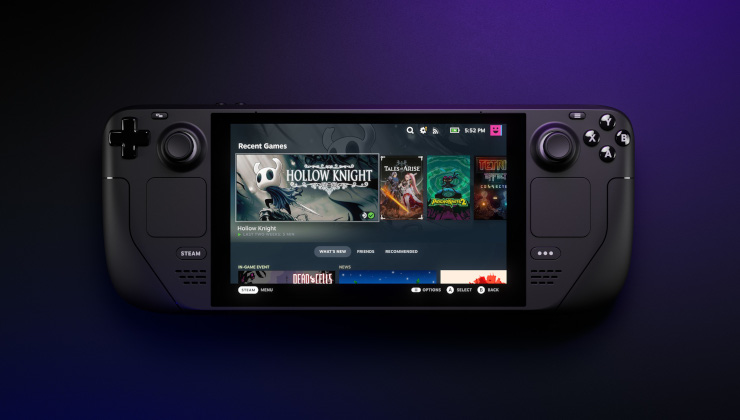
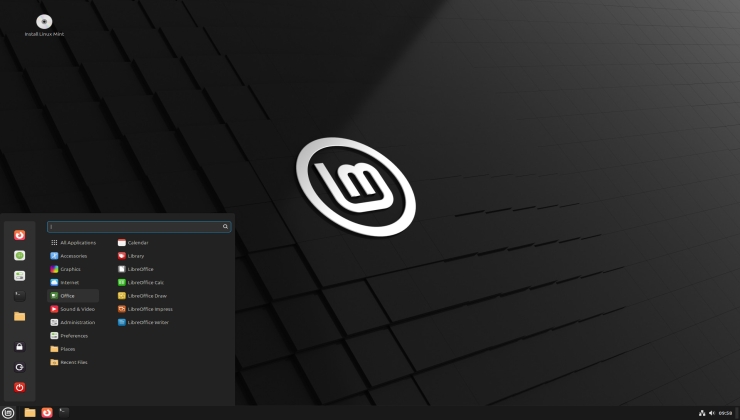
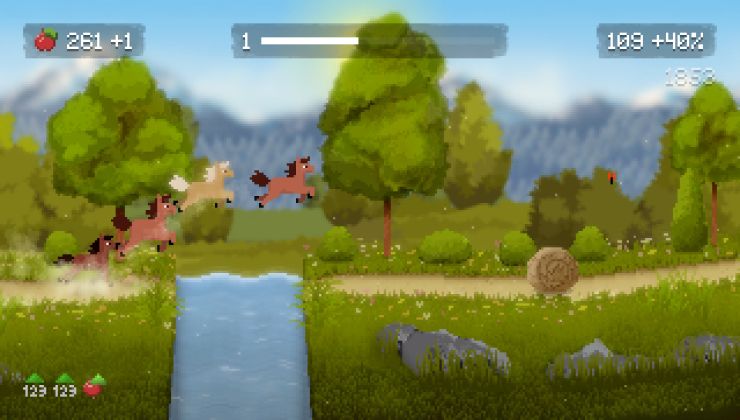
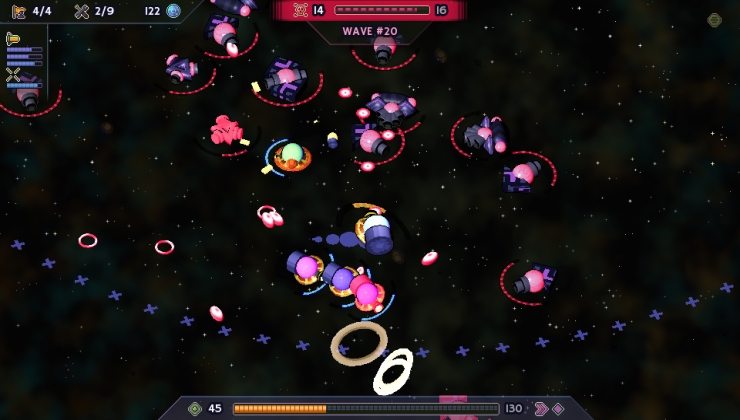







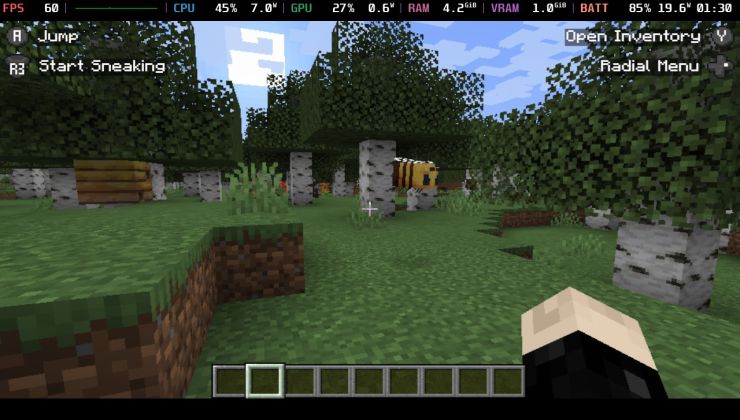 An idiots guide to setting up Minecraft on Steam Deck / SteamOS with controller support
An idiots guide to setting up Minecraft on Steam Deck / SteamOS with controller support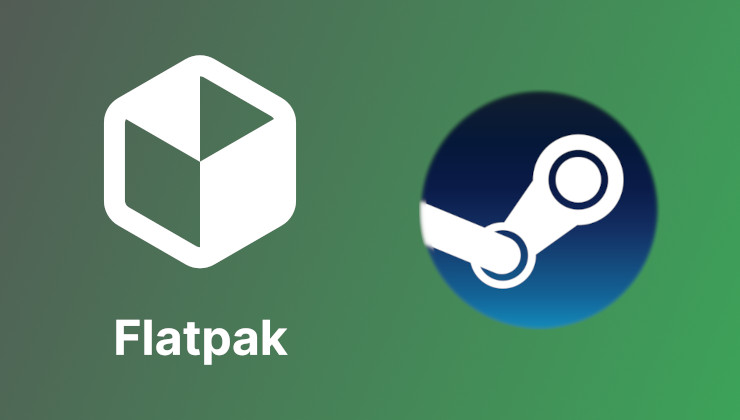 How to install extra software, apps and games on SteamOS and Steam Deck
How to install extra software, apps and games on SteamOS and Steam Deck
See more from me